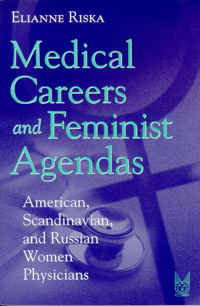

![]()
![]()

In the western world, the medical profession is experiencing a general decline in autonomy and prestige. At the same time, more women are entering the profession. Riska argues that women's progress within the profession has been determined to a large extent by wider external [economic conditions] and structural [conditions shaping job opportunities in the health care field] factors. In 1950, there was considerable international variation in the proportion of women physicians: 6% in the US, 21% in Finland, around 10% in other Scandinavian countries and 77% in the Soviet Union. Today, the Russian figures remain much the same whilst in the US they have risen to 25%. In Norway and Denmark they are around one third, 39% in Sweden and 50% in Finland. Riska sets out to explain why these gender differences persist.
Most of the early pioneers in medicine were also part of the wider women's movement. For example, in the US, they worked with women and children in the public health sphere. However, as medicine became increasingly scientific, public health medicine became separate from mainstream medicine. The rise of hospital medicine, with its hierarchical structure, produced further barriers for women physicians. US physicians largely remained in private practice until recent years. By contrast, in Scandinavia, women physicians were originally prohibited from working in the public sector and had to find their own niche in private practice.
Gender-segregated medical education was the norm in the US and Russia in the late 19th and early 20th centuries but not in Scandinavia. The feminist movement had a greater impact in the US than in Scandinavia where government policies embraced the ideology of gender equality and women were encouraged to participate in paid employment, supported by publicly funded childcare facilities.
In Russia, industrial employment was regarded as more important economically and politically than health and social care. Consequently, men were attracted to the former and women to the latter. The position of health care workers has not been improved by the lack of resources following the collapse of communism. Despite the high proportion of women physicians in Russia, women's health continues to be poor by international standards. Economic conditions are clearly more important for women's health than the gender composition of the medical workforce.
Male physicians are more likely to be self-employed, to work longer hours and to earn higher incomes. They are also more likely to hold the top positions in medical academia, although there are some signs of penetration of the medical glass ceiling. Women physicians continue to be concentrated in certain specialties and this pattern is common to most western countries. They are more likely to work with children (paediatrics) and the elderly (geriatrics) or do routine work (radiology). They remain a small minority in surgery. Riska's research on pathologists revealed a gendered division of labour within that specialty: for example, women pathologists were more likely to work with tissue samples from females and children.
Riska argues that women physicians should not be perceived as passive victims but as agents actively resisting and rejecting the masculine culture of medicine. Neither are they a homogeneous group. However, whilst essentialist and voluntaristic explanations do play a part in women doctors' career decisions, structural factors continue to be an important explanatory factor of their distribution throughout the profession.
I would highly recommend this book to anyone interested in gender in the professions, feminist theory or comparative studies. The book does, however, contain a considerable amount of information and therefore requires time to digest.
Fiona French
NHS Education for Scotland